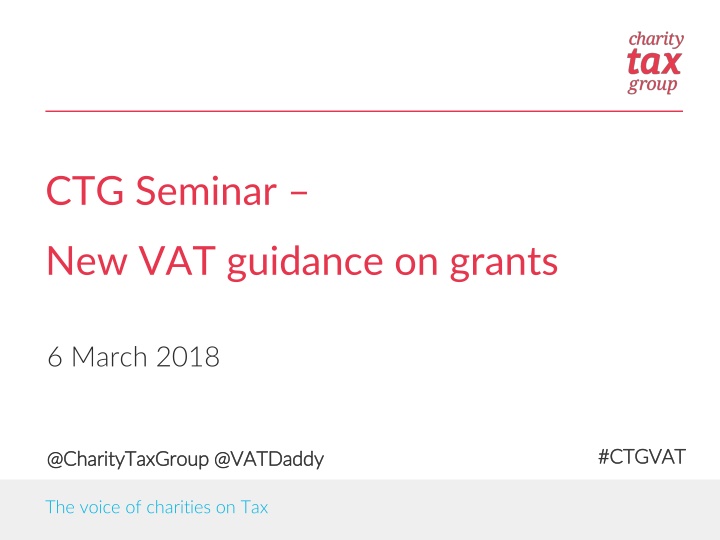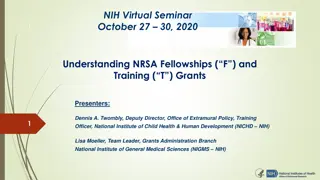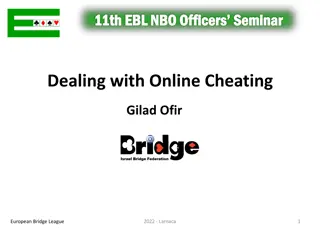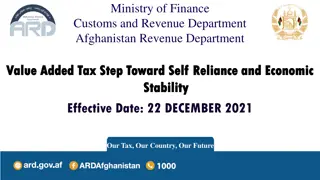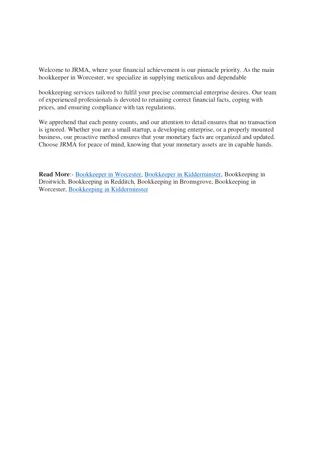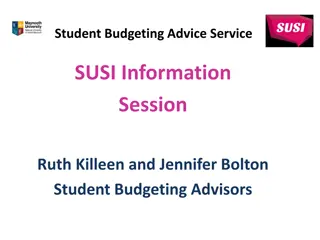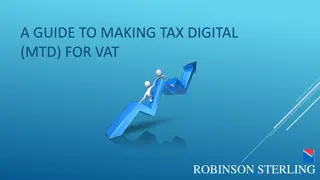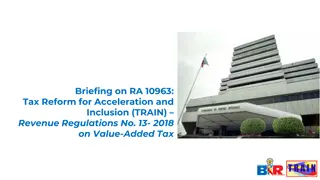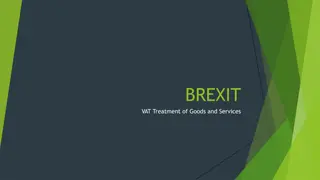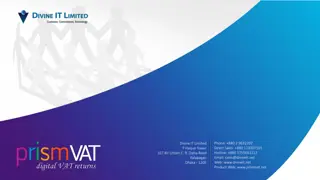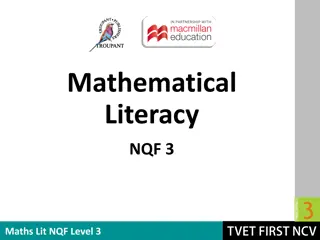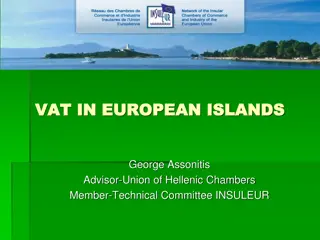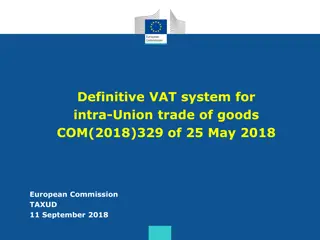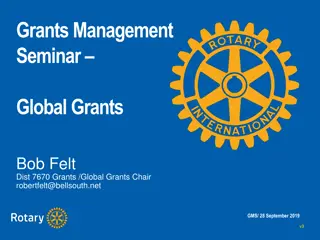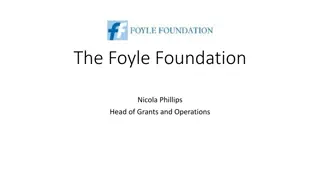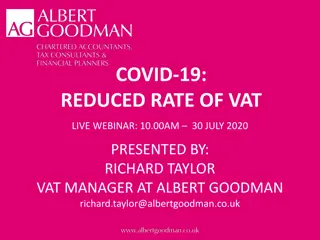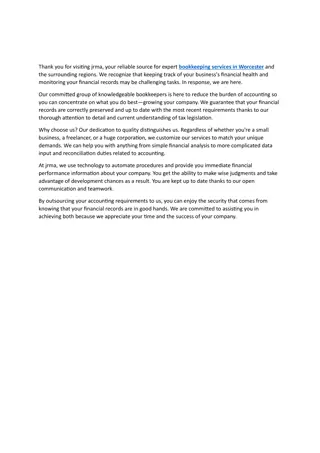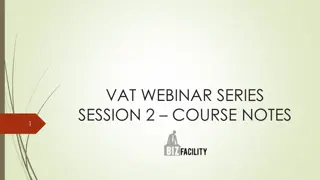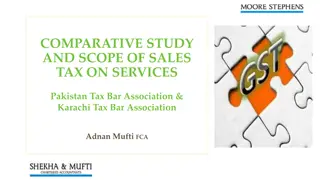New VAT Guidance on Grants: CTG Seminar Insights
CTG Seminar presented new VAT guidance on grants in March 2018, addressing HMRC's recent changes and implications for charities and advisors, highlighting the challenges faced and benefits of the updated guidance.
Download Presentation

Please find below an Image/Link to download the presentation.
The content on the website is provided AS IS for your information and personal use only. It may not be sold, licensed, or shared on other websites without obtaining consent from the author.If you encounter any issues during the download, it is possible that the publisher has removed the file from their server.
You are allowed to download the files provided on this website for personal or commercial use, subject to the condition that they are used lawfully. All files are the property of their respective owners.
The content on the website is provided AS IS for your information and personal use only. It may not be sold, licensed, or shared on other websites without obtaining consent from the author.
E N D
Presentation Transcript
CTG Seminar New VAT guidance on grants 6 March 2018 #CTGVAT #CTGVAT @ @CharityTaxGroup CharityTaxGroup @ @VATDaddy VATDaddy The voice of charities on Tax
New VAT guidance on grants Graham Elliott, CTG VAT Adviser #CTGVAT #CTGVAT @ @CharityTaxGroup CharityTaxGroup @ @VATDaddy VATDaddy The voice of charities on Tax
HMRC Guidance on VAT and funding from certain bodies This is also known as grants versus contracts , or grants versus consideration Late January 2018 HMRC published many pages of new guidance We had been expecting it for around 2 years We had seen an advanced draft, and made some comments, but CTG did not draft it, or any part of it The voice of charities on Tax
Why was this done? HMRC guidance had been very limited and did not appear to endorse any of the usual tools that assist us in analysing the position This omission left HMRC inspectors struggling to draw conclusions or explain their decisions Charities often lacked confidence in any view they had of the funding, and sought professional advice frequently Advisers struggled to draw concrete conclusions and were tempted to sit on the fence Charities were at risk of applying nuanced principles to a wide range of funding scenarios which were not necessarily sufficiently similar to be treated the same The voice of charities on Tax
That was then This is now But has the position changed, or are we in a different kind of fog? We think there is a meaningful improvement, but not a magic bullet Benefits: Benefits: 1. A charity can refer to a common resource with the inspector 2. The inspector has to have regard to that resource 3. It educates inspectors and forces them not to rely on gut feel 4. A charity can take a view on a more risk-calibrated basis 5. Advisers can show a client why they take the view they do 6. For the most part, HMRC guidance is consistent with professional opinion The voice of charities on Tax
Status of the guidance This is not new law EU legal principles continue to apply The guidance is not a decision tree which is binding on HMRC as with all manual guidance it does not actually bind HMRC, though they tend to acknowledge an obligation It s not possible to reduce the subject to black/white principles, so a significant element of grey, nuanced, and on balance conclusions will arise The answer It depends will continue to be a popular one The voice of charities on Tax
Layout of Guidance Consists of ten pages of intro and analysis, and twelve of case commentaries. Starts with general principles and moves towards more detailed points of interpretation. Requires the reader to stand back and consider all of the issues, so cannot be used as an automated decision tool. Also tells us what to ignore which might mislead us The voice of charities on Tax
Anything missing? We are concerned by a lack of reference to funding by Foundations (business sponsorship is covered by VATSC09000 and the Notice, but might have been worth including in the same general section) It is focussed seemingly entirely on public body funding Despite this, specific policies relating to DfID are not covered and there appears not to be any DfID related material in the manuals, despite there being indications that there is an agreement between DfID and HMRC Something substantive on Collaborational work between non-profits would have been good (based on university research guidance) Nothing on conduit funding (whether recipient is charging to manage funding or receives a grant) The voice of charities on Tax
Some key criteria emerge What the documentation calls a payment (its nomenclature) is not always accurate you need to look to the underlying facts It is only consideration where the payment is for or to parties the funder pays for not for a general good for a supply to the funder Where a public body makes payment from a fund which is not designated as one from which grants can be paid, it won t be a grant Where the payment arises from a formal procurement exercise by a public body, this will usually be for services to the funder (Note, these last two aspects aren t simple. How do you know the funding pot, and what if it s paid from both pots? Is the formal procurement realistically valid as a competitive exercise?) The voice of charities on Tax
The confusing page? - VATSC51640 #1 For a transaction to fall within the scope of VAT there must always be a supply, a consideration and a direct link between the two. A payment is not consideration for a supply if one of these factors is missing. The following points will help in deciding whether a payment is consideration for a supply for VAT purposes: Does the grantor receive anything in return for the payment? Are there any conditions attached to the payment that go beyond merely having to mention it in account statements? (cont.) The voice of charities on Tax
The confusing page? - VATSC51640 #2 What will the payments be used for? If the funder does not benefit directly, does any third party receive a benefit? Is there a contract and what are the terms and conditions? The voice of charities on Tax
Subsidy? #1 Type 2 directly linked to the price of a supply A subsidy forms part of the taxable consideration received by the supplier if it is directly linked to reducing the price to the customer. This is the case when a payment is paid to the producer, supplier or provider of goods or services; is paid by a third party to the supplier, and; constitutes consideration or part of the consideration for a supply of goods or services AND AND The voice of charities on Tax
Subsidy? #2 Indicators that the payment is this type of subsidy are: the payment must be paid in return for specific goods and/or services the payment has a direct effect on price or quantity in that the goods or services could not be provided at that price unless there was a subsidy the funder is specifically seeking to promote the supply of the particular goods or services there is an arithmetical relationship between a progression of the amount of the payment, the quantity produced and progression of the actual price of the goods or services provided the price of the goods or services is ascertainable and determined not later than the time of the payment to demonstrate the consumer benefitted from a particular amount being paid The voice of charities on Tax
Indicators of a supply within the scope All factors need to be considered, the more there are from each section the greater the evidence for a decision. However, it is not simply a matter of However, it is not simply a matter of indicators for exceeding indicators against , a balanced view needs to be indicators for exceeding indicators against , a balanced view needs to be formed taking all the applicable indicators into account. formed taking all the applicable indicators into account. You must consider the economic reality not just the contractual terms. The principal factor to consider is if a specific supply is made to the funder or a third party in return for a payment. If so then the payment is consideration for a supply, but if this direct link is not established then the payment can be treated as outside the scope of VAT. The voice of charities on Tax
Indicators outside scope #1 the payment was made following a grant application process run by an organisation that regularly provides outside the scope grants, such as central or local government are the funders the beneficiaries of the project? To be outside the scope of VAT a grant should be freely given. In using the payment, the supplier carries out its own charitable aims and objectives with the assistance of the money which is given with no expectation of direct benefit in return (cont.) The voice of charities on Tax
Indicators outside scope #2 the funder will not attempt to control how the money is spent beyond seeing that the funds are properly managed. Any monitoring is no more than simply ensuring the payments are appropriately spent the supplier will set its own targets as opposed to the funder imposing specific targets the payments are not treated as trading income or expenditure in the accounts of either party (cont.) The voice of charities on Tax
Indicators outside scope #3 if the funding is withdrawn there is no legal redress for the supplier to have the payment reinstated funding is drawn down by the supplier as a reimbursement of expenditure incurred, rather than an advance payment for services. Alternatively, there may be a deficit funding arrangement whereby the funder agrees to plug any funding gaps (cont.) The voice of charities on Tax
Indicators outside scope #4 the funding is provided under a statutory provision that empowers the funder to make a grant. This would be mainly relevant if the funder is a Government department or local authority there is a clawback provision within the agreement. Funders use this method to reclaim their funding in circumstances such as where not all the money was spent or if the terms of the agreement were not complied with. In contrast, a contract for a supply should not contain a clawback clause as there is no automatic right to reclaim any money. The money is consideration for the supply and the solution for reclaiming the payment in any subsequent breach of contract is to sue for damages The voice of charities on Tax
Indicators in scope #1 who initiates the agreement? If the funder is seeking services in return for their payment then this indicates the payment is consideration for supplies made to them if the funder is the direct beneficiary of the supplies. The funder believes they are receiving something in return for the payment. the supplier undertakes outsourced activities on behalf of the funder where the services provided are ones ordinarily provided by the funder so the supplier is acting as a subcontractor. Examples include the provision of functions ordinarily undertaken by local authorities that they have a statutory duty to perform and would face sanctions if they did not happen (cont.) The voice of charities on Tax
Indicators in scope #2 the contract is commercial in nature ie it is a legally binding contract connected to a business activity. This means looking for indicators such as penalty clauses being in place if the supplier does not fulfil their responsibilities and so is in breach of contract the supplies are undertaken as an economic activity. It is not necessary for the supplier to have a profit motive, but the type of supplies should have the potential to make a profit (cont.) The voice of charities on Tax
Indicators in scope #3 the relationship between the funder and supplier will be at arms length and there will be an absence of control from the funder in the supplier s decision making process the payments made by the funder to the supplier are made specifically for the supplier to provide particular services to its clients. The fact that the funder does not know at the time the service is provided the identity of the client or the even the specific service which is being provided is not relevant each activity carried out by the funder gives rise to a specific and identifiable payment. This is an agreed sum, either a single payment or a sum per activity ie the more work done, the greater the payment. For this to happen there is probably a detailed recording system for timekeeping, outputs achieved etc (cont.) The voice of charities on Tax
Indicators in scope #4 the funder will attempt to control how the money is spent, maybe imposing specific targets in terms of quantity, quality, timeframes etc. Any monitoring is more than simply ensuring the payments are spent properly and is to ensure that specific supplies are made if the funding is withdrawn there is legal redress for the supplier to have the payment reinstated or claim compensation the payments are treated as trading income or expenditure in the accounts of either party The voice of charities on Tax
Neutral Factors #1 the payment is described as a grant in the contract and correspondence. Whilst the wording of a contract is important, what the payment is called does not determine its VAT treatment the level of detail within the contract/agreement does not point in either direction, ie it is wrong to say that the more detail there is, the more likely there is a contract for a supply the supplier is obliged to provide reports and information to the funder. This is not an indicator either way as a condition in the agreement to report on how the payments are used will be required either to confirm supplies were made or in a grant situation act as good housekeeping to ensure the money is spent for its intended purpose (cont.) The voice of charities on Tax
Neutral Factors #2 the supplier s activities and the number of projects undertaken are influenced by the payment ie they would be significantly curtailed in the event of a withdrawal or reduction in funding. Although this could indicate there was a supply made to the funder, you must still look at whether a supply is actually made to them, as a withdrawal of a grant may equally mean a reduction in service provision The voice of charities on Tax
Case law section Seems almost a random layout no discernible journey Starts with some very old and probably dubious decisions relating to advice to the community Wolverhampton; Hillingdon are these still valid Healthwatch Hampshire excluded. Why? Not clear how easy some of the very long commentary will be to get to grips with The voice of charities on Tax
Summary view Welcome addition to guidance, but could be made more easy for the charity user by being set out in a Notice We understand that changes can be made by HMRC if convincing suggestions are made These may plug the gaps in what appears to be guidance slanted towards public funding issues Not all of the tests appear convincing, but opinions will vary Lacks an imaginative policy element, but perhaps that s more than can be expected Does not change the landscape very much which will reassure many The proof of the pudding will be in the eating The voice of charities on Tax
Q&A #CTGVAT #CTGVAT @ @CharityTaxGroup CharityTaxGroup @ @VATDaddy VATDaddy The voice of charities on Tax
Charity Tax Group Leading representative body for charities on tax issues Over 500 Charity and Observer members Lobbying and information provision role www.charitytaxgroup.org.uk provides access to regular newsletters and consultation & case law trackers Join today! The voice of charities on Tax
Charity Tax Group For more information or to register for the CTG newsletter contact us at: 020 7222 1265 info@charitytaxgroup.org.uk www.charitytaxgroup.org.uk @CharityTaxGroup Support CTG in 2018! The voice of charities on Tax
